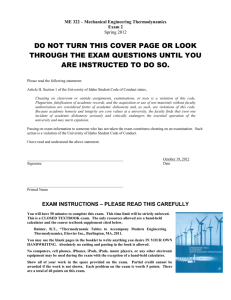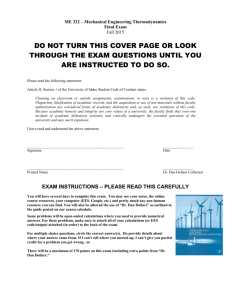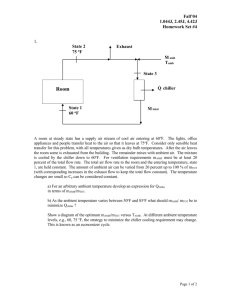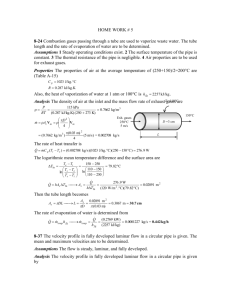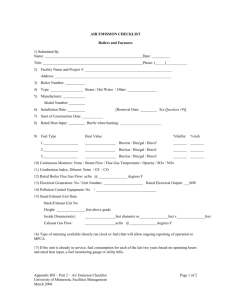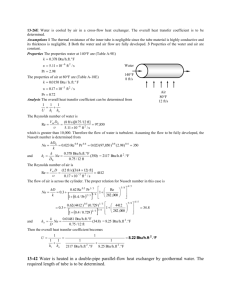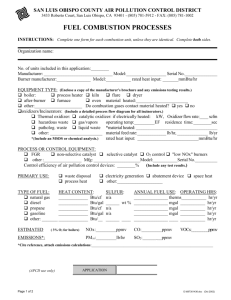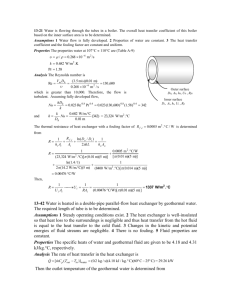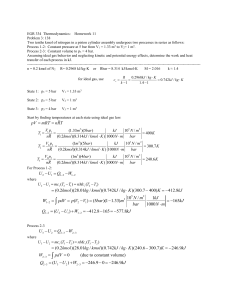HW Set 19: Chap 4: 94, 100, 106
advertisement
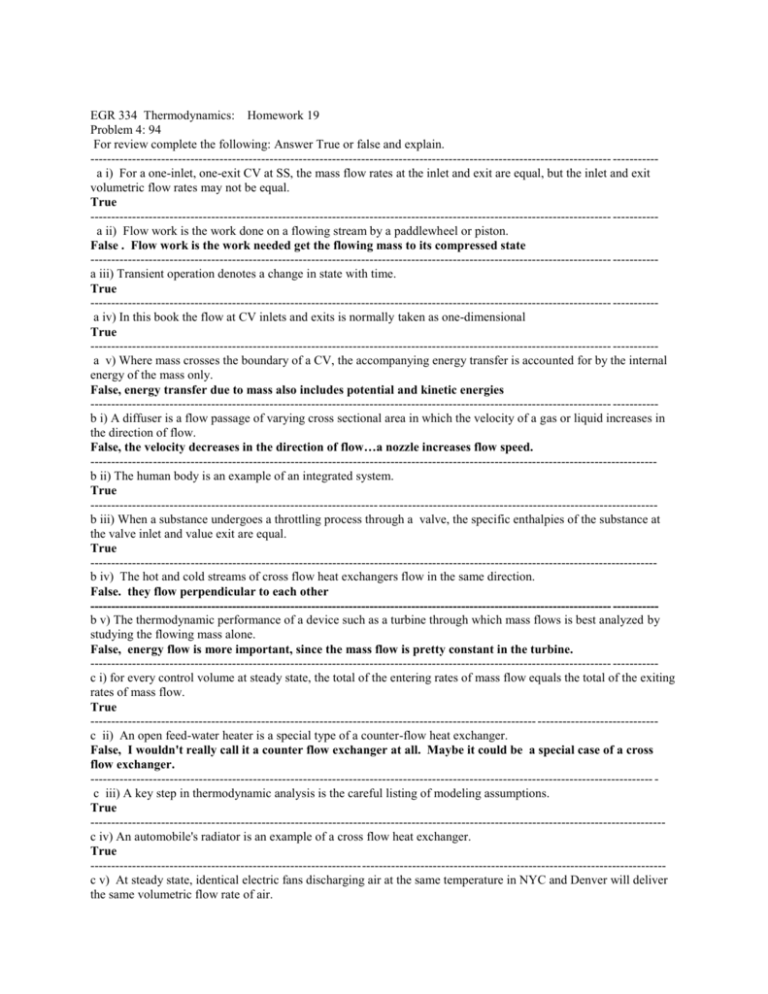
EGR 334 Thermodynamics: Homework 19 Problem 4: 94 For review complete the following: Answer True or false and explain. ----------------------------------------------------------------------------------------------------------------------------- ----------a i) For a one-inlet, one-exit CV at SS, the mass flow rates at the inlet and exit are equal, but the inlet and exit volumetric flow rates may not be equal. True ----------------------------------------------------------------------------------------------------------------------------- ----------a ii) Flow work is the work done on a flowing stream by a paddlewheel or piston. False . Flow work is the work needed get the flowing mass to its compressed state ----------------------------------------------------------------------------------------------------------------------------- ----------a iii) Transient operation denotes a change in state with time. True ----------------------------------------------------------------------------------------------------------------------------- ----------a iv) In this book the flow at CV inlets and exits is normally taken as one-dimensional True ----------------------------------------------------------------------------------------------------------------------------- ----------a v) Where mass crosses the boundary of a CV, the accompanying energy transfer is accounted for by the internal energy of the mass only. False, energy transfer due to mass also includes potential and kinetic energies ----------------------------------------------------------------------------------------------------------------------------- ----------b i) A diffuser is a flow passage of varying cross sectional area in which the velocity of a gas or liquid increases in the direction of flow. False, the velocity decreases in the direction of flow…a nozzle increases flow speed. ---------------------------------------------------------------------------------------------------------------------------------------b ii) The human body is an example of an integrated system. True ---------------------------------------------------------------------------------------------------------------------------------------b iii) When a substance undergoes a throttling process through a valve, the specific enthalpies of the substance at the valve inlet and value exit are equal. True ---------------------------------------------------------------------------------------------------------------------------------------b iv) The hot and cold streams of cross flow heat exchangers flow in the same direction. False. they flow perpendicular to each other ----------------------------------------------------------------------------------------------------------------------------- ----------b v) The thermodynamic performance of a device such as a turbine through which mass flows is best analyzed by studying the flowing mass alone. False, energy flow is more important, since the mass flow is pretty constant in the turbine. ----------------------------------------------------------------------------------------------------------------------------- ----------c i) for every control volume at steady state, the total of the entering rates of mass flow equals the total of the exiting rates of mass flow. True ----------------------------------------------------------------------------------------------------------- ----------------------------c ii) An open feed-water heater is a special type of a counter-flow heat exchanger. False, I wouldn't really call it a counter flow exchanger at all. Maybe it could be a special case of a cross flow exchanger. --------------------------------------------------------------------------------------------------------------------------------------- c iii) A key step in thermodynamic analysis is the careful listing of modeling assumptions. True -----------------------------------------------------------------------------------------------------------------------------------------c iv) An automobile's radiator is an example of a cross flow heat exchanger. True -----------------------------------------------------------------------------------------------------------------------------------------c v) At steady state, identical electric fans discharging air at the same temperature in NYC and Denver will deliver the same volumetric flow rate of air. True, but the fans will likely have different mass flow rates since air densities will be different. EGR 334 thermodynamics: homework 19 Problem 4: 100 Carbon dioxide modeled as ideal gas flows through the compressor and heat exchanger shown. The power input to the compressor is 100 kW. A separate liquid cooling water stream flows through the heat exchanger. All given data is at steady state. Stray heat transfer with the surroundings can be neglected. Determine a) mass flow rate of the CO2 in kg/s b) the mass flow rate of the cooling water in kg/s -----------------------------------------------------------------CO2 as ideal gas Cooling water State 1: p1 = 100 kPa T 4 = 20 C T1 = 280 K State 2: p2 = 1 MPa T 5 = 30 C T2 = 500 K State 3: T3 = 350 K Wcompressor = 100 kW. From Table A-20, use cp(T=400K) ≈ 0.939 kJ/kg-K Compressor Model: 0 W mCO 2 (h1 h2 ) 0 (Wcompressor ) mCO2 c p (T1 T2 ) mCO 2 Wcompressor cv (T2 T1 ) 100kW kJ / s 0.484kg / s (0.939kJ / kg K )(500 280) K kW Heat Exchanger Model: 0 mCO 2 (h2 h3 ) mH 20 (h4 h5 ) 0 mCO 2cv (T2 T3 ) mH 20 (h4 h5 ) m c (T T ) mH 20 CO 2 v 3 2 (h4 h5 ) where h4=hf(T=20C) = 83.96 kJ/kg mH 20 and h5=hf(T=30C)= 125.79 kJ/kg (0.484kg / s)(0.939kJ / kg K ))(350 500) K 1.63kg / s (83.96 125.79)kJ / kg EGR 334 Thermodynamics: Homework 19 Problem 4: 106 A simple gas turbine power cycle operating at steady state with air as the working substance is shown. The cycle components include an air compressor mounted on the same shaft as the turbine. The air is heated in the high pressure heat exchanger before entering the turbine. The air exiting the turbine is cooled in the lower pressure heat exchanger before returning to the compressor. KE and PE effects are small. The compressor and turbine are adiabatic. Using the ideal gas model for air, determine a) power required for the compressor in hp b) the power output of the turbine in hp c) the thermal efficiency of the cycle. --------------------------------------------------------------------Ideal gas model with Air. State 1: p1 = 1 atm T1 = 520 R (AV)1 = 30000 ft3/min State 2: T2 = 650 R State 3: p3= p2 T3 = 2000 R State 4: p4 = p1 = 1 atm T4 = 980 R R for air = 0.06855 Btu/lbm-R cp(520 R) = 0.248 Btu/lbm-R cp(650 R) =0.252 Btu/lbm-R cp(2000 R)=0.286 Btu/lbm-R cp(980R) =0.259 Btu/lbm-R from state 1 and ideal gas law: pV mRT 2 p1 ( AV)1 pV (1atm)(30000 ft 3 / min) 14.7lb f / in Btu 144in 2 m 2290 lbm / min RT RT1 (0.06855 Btu / lbm R)(520 R) atm 778lb f ft 1 ft 2 Energy balance: 0 Q W mi (hi Process 1-2: Vi 2 V2 gzi ) me (he e gze ) 2 2 adiabatic, no change of KE or PE. Use cp_ave = 0.250 Btu/lbm-R 0 (Wcompressor ) m(h1 h2 ) Wcompressor m(h2 h1 ) mc p (T2 T1 ) (2290lbm / min)(0.250Btu / lbm - R)(650 520)R 74425Btu / min 1754.6HP Process 2-3: W= 0 and no change of KE or PE Use cp_ave = 0.269 Btu/lbm-R 0 Qin m(h2 h3 ) Qin m(h3 h2 ) mcp (T3 T2 ) (2290lbm / min)(0.269Btu / lbm R)(2000 650)R 831613.5Btu / min Process 3-4: adiabatic, no change of KE or PE. cp_ave = 0.273 Btu/lbm-R 0 Wcompressor Wnet m(h3 h4 ) Wnet m(h3 h4 ) Wcompressor (2290lbm / min)(0.273Btu / lbm R)(2000 980) R 74425Btu / min 563248 Btu / min 13279 HP Process 4-1: no change of KE or PE c p_ave = 0.254 Btu/lbm-R 0 Qout m(h4 h1 ) Qout m(h4 h1 ) mc p (T4 T1 ) (2290lbm / min)(0.254Btu / lbm R)(980 520)R 267653 Btu / min Therefore the power output of the turbine is Wnet 563248 Btu / min and the thermal efficiency may be found as Wnet 563248 Btu / min 0.677 67.7% Qin 831613.5Btu / min

